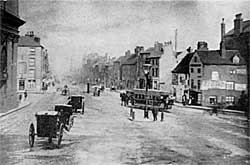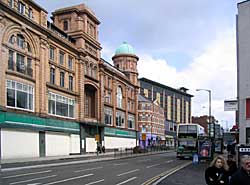< Previous | Contents | Next >
Parliament Street

Looking down Parliament Street from Theatre Square, c1880.
Parliament Street is quite a modern name for an ancient thoroughfare, which as early as 1576 was known as "The Back Side." We have seen how the lay-out of Long Row into narrow and long strips, divided by numerous footpaths and with very short frontages to the busy Market Place denotes its early origin, and the Back Side was associated with this lay-out, for it afforded access to the rear of these long, narrow strips.
In 1770, there dwelt hereabouts a man of the name of Rouse, who, notwithstanding the fact that he was not quite mentally normal, had great political aspirations. Above all things, he desired to be elected a member of Parliament, but his wishes, not unnaturally found little favour with his fellow-townsmen. In order to emphasize his pretentions, he caused a number of boards bearing the name "Parliament Street" to be prepared and exhibited in the Back Side. The innovation had no effect on his destinies, but the name struck our forefathers as being dignified and suitable, and has been applied to the thoroughfare ever since.
The very welcome width of both Upper and Lower Parliament Street has an historical significance, and is due to the fact that the Town Wall of Henry II's time ran down its midst almost from end to end. Traces of the foundations and lower courses of this wall have been found from time to time, notably in 1864 and again about 1900, so that its exact position is well known to antiquaries. On its outer side was a wide ditch and on its inner side, as is usual in cases of defensive walls throughout the realm, was a lane which ran round the whole area and facilitated the traffic of the defenders from point to point of their fortification. We do not know exactly when the wall was abandoned, but at any rate by Tudor times its use would have vanished and it would probably have so far decayed that its ruins would either be thrown down and used to fill up the town ditch, or else used as a quarry for building purposes. Anyway, the site of the wall itself, together with the outer ditch and the inner lane, were thrown into one spacious thoroughfare which is so welcome to us nowadays.
But this spaciousness was not always appreciated as much as it is to-day, and so, in 1625 we find that for a simple fee of £6 13s. 4d. permission was granted to Thomas Jackson and his heirs to erect a row of tenements in the midst of Lower Parliament Street, which afterwards became known as Parliament Row. The granting of this permission was a very costly mistake, for when Parliament Row was finally cleared away in 1884, the alteration cost the town £20,000.

Looking east along Upper Parliament Street from Chapel Bar (A Nicholson, 2004).
About 1732, Parliament Street was very narrow at its Chapel Bar end, and somewhere about where Toll Street now enters Parliament Street stood the Dolphin Inn, one of the little group of inns which sprang up outside the Chapel Bar for the accommodation of wayfarers arriving after the gates were closed for the night, and which may possibly derive its name from the Dauphin. Tobias meant to stay at this inn in 1732, on one of his visits to Nottingham, but apparently he had been there before and he received a letter from the landlord's daughter not only refusing him accommodation, but requesting that neither he nor his lady friends (who were roundly described as "Bedizened play-women from the fair") would visit the house. Tobias took his revenge by conducting Bouncing Bella to call on the landlord of the Dolphin disguised as a "parson's lady," dressed in a black mantilla, veil and gloves.
In front of this inn was one of the many common wells of the town, but all trace of this has long since disappeared, as have the row of fine poplar trees which stretched down the middle of Parliament Street until they were felled in 1791. Until 1853, the entrance to Parliament Street from Chapel Bar was extremely narrow, but in that year it was so widened as to allow of two vehicles passing each other, and this was sufficient for dealing with traffic until the advent of electric trams about 1902, when the road was altered to its present width. At the north-west corner of the old street was erected St. George's Hall. It was opened with much eclat in 1853 by a concert in aid of the victims of the Crimean War, but it never seems to have enjoyed much popularity, and in 1902 it was pulled down to make way for street improvements.
The narrow passages and yards which connect Parliament Street with Long Row are worthy of exploration, for they present many curious and interesting features, and some of them have their story to tell, as, for instance, has Talbot Yard where, in 1850, Mr. Shaw, the eccentric founder of the great leather firm that bears his name, met with his fatal accident.
The three-storied house on the south side was used as a convent for a number of years prior to the erection of the modern establishment in College Street.
The Theatre Royal was erected in 1875 from the designs of the architect Phipp, and its portico with fine Corinthian capitals is a beautiful composition. The theatre stands upon a part of the old sand field, or sheep walk of the town, and for a long time there had been nothing on the site except a few houses and a small inn. All to the north was open fields. The theatre itself is of some importance in theatrical history, for it was in it that such plays as "The Scarlet Pimpernel" and "The Sign of the Cross" were produced, and within its walls Lewis Waller played his last part.
Mrs. Kendal, as Madge Robertson, was also associated with the Theatre Royal, and a perfectly charming story is told about her. One day a friend of hers brought his bride to the green room and introduced her to the great actress, saying that folk commented on the great likeness between the two ladies. Mrs. Kendal critically surveyed the blushing bride, and then said to her, "Folk say we're just alike; well, my dear, I've had a good look at you and if what folk say is true, I'm quite satisfied."
Where King's Walk is now constructed, Robert Goodacre in 1799 conducted the Nottingham Academy which was afterwards transferred to Standard Hill. It was at this Academy that Lord Byron received a part of his early education. It was near here, at the junction of Clumber Street and Parliament Street, that the Nottingham Maypole stood with a well hard by. After the election of 1715, Sir Charles Sedley had given the tallest fir pole that could be found to serve as a maypole, and this served until 1747, when it was replaced by a new one which stood until 1789, in which year, one Thomas Wyer, the Overseer of Highways, took it into his head to pull it down without any reason.
The Cow Lane Bar, which was one of the gateways to Nottingham, stood at this crossing, and very little is known about it. Probably it was very similar to Chapel Bar.
An archway leading into the yard of number eleven (St. Stephen's Buildings) is noteworthy, for it is the chancel arch of St. Stephen's Church, a modern structure built in 1869, pulled down to make way for the Victoria Station. Parliament Street Chapel is on an interesting site, for it was hereabouts that the curious Nottingham Pottery was made during the 15th century. Many finds of this pottery have taken place, and there is a good collection of specimens in the Castle Museum. A chapel for the Methodist New Connection was commenced here in 1816, and it was enlarged in 1826. The present structure was erected in 1875. It was almost opposite this chapel on the site now occupied by the Victoria Station that William and Mary Howitt lived for some time, and it was there, I believe, that The Spider and the Fly was written.
